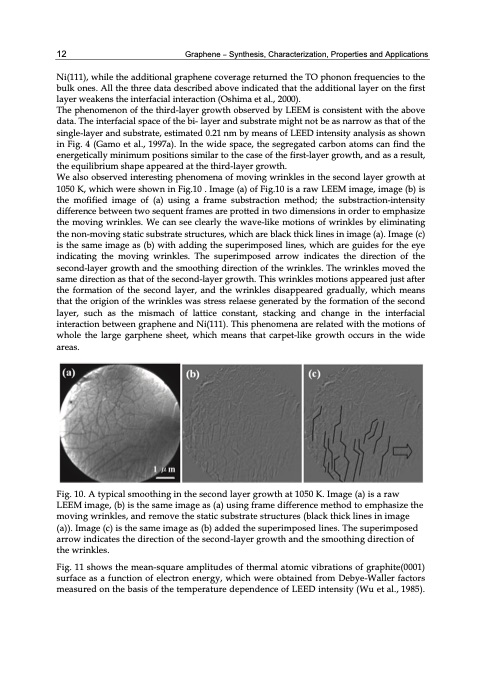
PDF Publication Title:
Text from PDF Page: 022
12 Graphene – Synthesis, Characterization, Properties and Applications Ni(111), while the additional graphene coverage returned the TO phonon frequencies to the bulk ones. All the three data described above indicated that the additional layer on the first layer weakens the interfacial interaction (Oshima et al., 2000). The phenomenon of the third-layer growth observed by LEEM is consistent with the above data. The interfacial space of the bi- layer and substrate might not be as narrow as that of the single-layer and substrate, estimated 0.21 nm by means of LEED intensity analysis as shown in Fig. 4 (Gamo et al., 1997a). In the wide space, the segregated carbon atoms can find the energetically minimum positions similar to the case of the first-layer growth, and as a result, the equilibrium shape appeared at the third-layer growth. We also observed interesting phenomena of moving wrinkles in the second layer growth at 1050 K, which were shown in Fig.10 . Image (a) of Fig.10 is a raw LEEM image, image (b) is the mofified image of (a) using a frame substraction method; the substraction-intensity difference between two sequent frames are protted in two dimensions in order to emphasize the moving wrinkles. We can see clearly the wave-like motions of wrinkles by eliminating the non-moving static substrate structures, which are black thick lines in image (a). Image (c) is the same image as (b) with adding the superimposed lines, which are guides for the eye indicating the moving wrinkles. The superimposed arrow indicates the direction of the second-layer growth and the smoothing direction of the wrinkles. The wrinkles moved the same direction as that of the second-layer growth. This wrinkles motions appeared just after the formation of the second layer, and the wrinkles disappeared gradually, which means that the origion of the wrinkles was stress relaese generated by the formation of the second layer, such as the mismach of lattice constant, stacking and change in the interfacial interaction between graphene and Ni(111). This phenomena are related with the motions of whole the large garphene sheet, which means that carpet-like growth occurs in the wide areas. Fig. 10. A typical smoothing in the second layer growth at 1050 K. Image (a) is a raw LEEM image, (b) is the same image as (a) using frame difference method to emphasize the moving wrinkles, and remove the static substrate structures (black thick lines in image (a)). Image (c) is the same image as (b) added the superimposed lines. The superimposed arrow indicates the direction of the second-layer growth and the smoothing direction of the wrinkles. Fig. 11 shows the mean-square amplitudes of thermal atomic vibrations of graphite(0001) surface as a function of electron energy, which were obtained from Debye-Waller factors measured on the basis of the temperature dependence of LEED intensity (Wu et al., 1985).PDF Image | GRAPHENE SYNTHESIS CHARACTERIZATION PROPERTIES

PDF Search Title:
GRAPHENE SYNTHESIS CHARACTERIZATION PROPERTIESOriginal File Name Searched:
Graphene-Synthesis.pdfDIY PDF Search: Google It | Yahoo | Bing
Salgenx Redox Flow Battery Technology: Power up your energy storage game with Salgenx Salt Water Battery. With its advanced technology, the flow battery provides reliable, scalable, and sustainable energy storage for utility-scale projects. Upgrade to a Salgenx flow battery today and take control of your energy future.
| CONTACT TEL: 608-238-6001 Email: greg@infinityturbine.com | RSS | AMP |